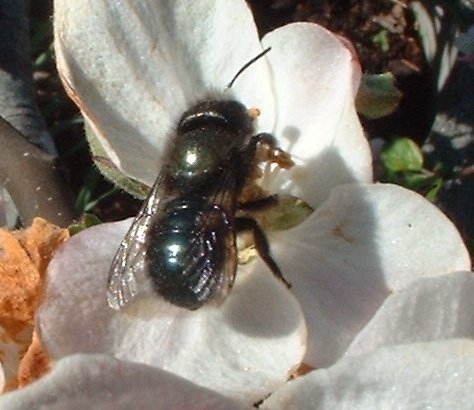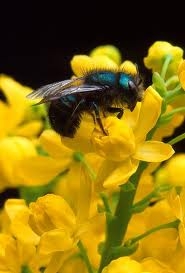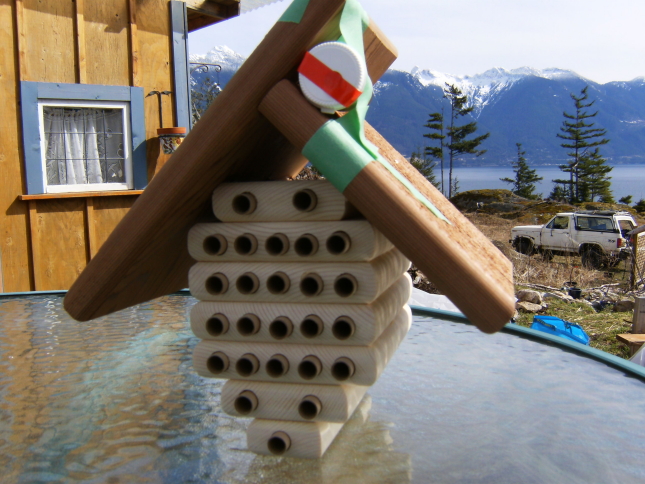Mason Bee
Mason bees are small, native bees that few people knew existed even 5-10 years ago. As the crisis with our honey bees worsened, people began looking for other insects that were capable of pollinating our fruit trees, shrubs, flowers and other crops that require bees.
 The Blue Orchard Mason bee is commonly found in the coastal regions and the southern interior of BC. They favor woodlands, orchards and forest edges. Although they appear black, these small bees are actually a dark, metallic green or blue. Females are robust and larger (14 mm) than the male bees (11-12 mm) and resemble a small, hairy, black fly. The males have long antennae on a more slender body. Due to the hairiness of these bees, they make excellent pollinators, carrying pollen grains from flower to flower.
The Blue Orchard Mason bee is commonly found in the coastal regions and the southern interior of BC. They favor woodlands, orchards and forest edges. Although they appear black, these small bees are actually a dark, metallic green or blue. Females are robust and larger (14 mm) than the male bees (11-12 mm) and resemble a small, hairy, black fly. The males have long antennae on a more slender body. Due to the hairiness of these bees, they make excellent pollinators, carrying pollen grains from flower to flower.

What makes these bees perfect for agriculture, including home gardeners, are two traits. One is their non-aggressiveness. Mason bees are shy creatures and would rather fly away than protect either their feeding grounds or nests. Although they can sting, they seldom do. These bees, although they do not form a hive like honeybees, will nest together for protection, making it easy to keep large numbers together. Any area that can be tunneled into, like cedar shakes, older wood, spaces between bricks or siding, will be turned into a nest. Mason bee nesting boxes are also readily accepted. Boxes are usually a simple 3-sided frame with either holes drilled into a centre block or removable paper tubes for the females to lay their eggs. The tubes/holes should be 7-8 mm wide. Paper tubes are easier to use as they can be disposed off each season and don't need to be cleaned out like the wooden blocks.
The Life Cycle of the Mason Bee
In spring, around March or April the males emerge first and begin sunning themselves waiting for the females. Several consecutive warm days are needed before this occurs (for this reason, it is best to place the nesting box in a sunny locations). Once the females emerge, mating takes place, She will then find a suitable area to lay her eggs, either the nesting box where she emerged or other small holes First, she will seal the back of the nesting tube with a mud plug. Then she will begin gathering pollen and nectar to place in the compartment she has begun as food for the egg. Once enough has been accumulated, she then places an egg onto the food deposit and plugs it with a mud plug. This cycle is repeated until the tube is filled, usually with 7-11 eggs. The last couple chambers are "dummy" ones, left empty as a defense against predators. Female eggs are laid at the back, male eggs laid at the front of the tube. A female mason bee lives for one month which is spent laying 1-2 eggs a day: she will lay about 35 eggs in that time. After that month, she dies.
Inside the nesting chamber, the egg hatches and the larvae feeds on the food available. Once it is consumed, the larvae will then pupate and stay in this form during the spring and summer. By late summer, the pupae will develop into an adult but it will stay in the cocoon, hibernating until spring when the cycle begins again.
 To the left is a popular design for a mason bee house. The tubes are removable and there is space below the roof to place last year's tubes. Here, the cocoons are placed in a pill vial with a hole in it (above the "V" in the roof)
To the left is a popular design for a mason bee house. The tubes are removable and there is space below the roof to place last year's tubes. Here, the cocoons are placed in a pill vial with a hole in it (above the "V" in the roof)
Care of Your Mason Bees
It is important to leave the nesting tubes outside for the summer months to aid in the development of the young bees. You may need to guard the box from woodpeckers, who find them a tasty snack. Simply use a small mesh wire and tack it over the entrance of the box so they can't reach the tubes. In October, remove the tubes and place them in a cool, frost free location. If you are concerned about pollen mites or small Chalcid wasp eggs in your tubes, you can remove the cocoons from the tubes and wash them in a 5% bleach solution. Rinse and dry well. In early March, place the tubes (or cocoons) by the nesting box and fill the holes with fresh tubes. Our nesting boxes do have spaces where you can place your tubes so that when the bees emerge, they will find their old nest waiting for them with fresh, new tubes.
Or you can use a plastic bee house which is very easy to clean. Simply open up the nesting tube block, remove the bees and wash the tray. No tubes need to be replaced and the house is ready to use for next year.
Interesting Facts
These bees have no "pollen sacs" like honey bees, instead they carry the pollen on the many fine hairs on their body

